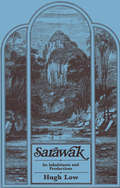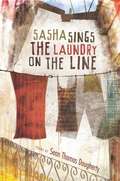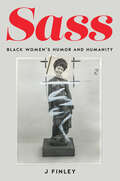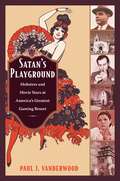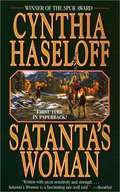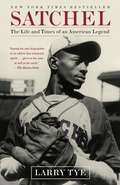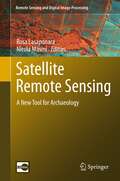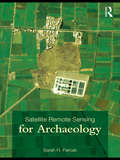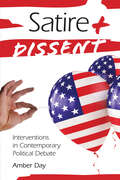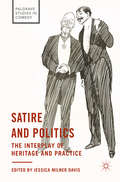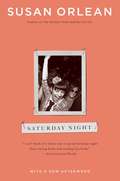- Table View
- List View
Sarawak: Its Inhabitants and Productions
by Hugh LowFirst Published in 1968. This book contains remarks made from the author’s notes collected during a residence of about thirty months in Sarawak, and the west coast of Borneo. The initial focus of the visit (the collection of plants and seeds,) led him more into the country, and amongst the tribes of aborigines, than any other Englishman who has yet visited the shores of this Island at the time.
Sardar Patel: An Icon of India’s Unity
by Harish K. ThakurThe political landscape of India has undergone significant transformation in the twenty-first century. With the rise of the Bharatiya Janata Party as a strong nationalist force, historical figures such as Sardar Patel, Vinayak Damodar Savarkar, and Deendayal Upadhyaya have been projected as key heroes of the freedom struggle alongside others. This has led to a redefinition and reprioritization of the leadership profile of the Indian independence movement.This book tries to understand Sardar Patel not from the traditional approach of viewing him just as an integrator of princely states or Iron Man but investigate the different dimensions of Patel’s thinking towards India. It discusses his ideas on secularism and minorities, status of women, ideas on cleanliness and environment, scheduled castes, Indian administration, farmers and agricultural rights and land reforms, India’s foreign policy and relations with its neighbours especially China and the greater world powers.First of its kind, this book will be of interest to scholars and researchers of Indian politics, Indian history, Nationalist movement, political sociology, and South Asian history.
Sars: Reception and Interpretation in Three Chinese Cities (Routledge Contemporary China Series #Vol. 17)
by Deborah Davis Helen SiuSARS (Acute Respiratory Syndrome) first presented itself to the global medical community as a case of atypical pneumonia in one small Chinese village in November 2002. Three months later the mysterious illness rapidly spread and appeared in Vietnam, Hong Kong, Toronto and then Singapore. The high fatality rate and sheer speed at which this disease spread prompted the World Health Organization to initiate a medieval practice of quarantine in the absence of any scientific knowledge of the disease. Now three years on from the initital outbreak, SARS poses no major threat and has vanished from the global media. Written by a team of contributors from a wide variety of disciplines, this book investigates the rise and subsequent decline of SARS in Hong Kong, mainland China and Taiwan. Multidisciplinary in its approach, SARS explores the epidemic from the perspectives of cultural geography, media studies and popular culture, and raises a number of important issues such as the political fate of the new democracy, spatial governance and spatial security, public health policy making, public culture formation, the role the media play in social crisis, and above all the special relations between the three countries in the context of globalization and crisis. It provides new and profound insights into what is still a highly topical issue in today’s world.
Sartorial Practices and Social Order in Eighteenth-Century Sweden: Fashioning Difference (Routledge Studies in Eighteenth-Century Cultures and Societies)
by Mikael AlmThe interplay between clothes and social order in early modern societies is well known. Differences in dress and hierarchies of appearances coincided with and structured social hierarchies and notions of difference. However, clothes did not merely reproduce set social patterns. They were agents of change, actively used by individuals and groups to make claims and transgress formal boundaries. This was not least the case for the revolutionary decades of the late eighteenth century, the period in focus of this book. Unlike previous studies on sumptuary laws and other legal actions taken by governments and formal power holders, this book offers a broader and more everyday perspective on late eighteenth-century sartorial discourse. In 1773, there was a publicly announced prize competition on the advantages and disadvantages of a national dress in Sweden. Departing from the submitted replies, the study opens a window onto the sartorial world. Several fields of cultural history are brought together: social culture in terms of order, hierarchies, and notions of difference; sartorial culture with contemporary views on dress and moral aspects of sartorial practices; and visual culture in terms of sartorial means of making a difference and the emphasis on the necessity of a legible social order.
Sartre, Existentialism, and the New Age of Nausea
by Stuart SimThis book explores the relevance of Sartrean existentialism to the contemporary socio-political landscape, with particular reference to his early novel Nausea and the concepts of bad faith and authenticity outlined in his major philosophical work Being and Nothingness. In an era where political authoritarianism has asserted itself so powerfully internationally and climate crisis has revealed the shortcomings of the political class so sharply, Stuart Sim argues that existentialism has much to offer as a worldview in addressing such issues. The sense of a world order falling apart connects us strongly to Sartre's situation in the Europe of the 1930s and 40s, when fascism was in the ascendant and human rights under severe threat as a direct consequence. To read Sartre's work through these phenomena is to realise the renewed importance of key existentialist concepts to the current geopolitical situation.
Sarvodaya
by M. K. Gandhiસૉક્રેટિસે માણસને શું કરવું ઘટે છે તેનું થોડુંક દર્શન કરાવ્યું. તેણે જેવું કહ્યું તેવું જ કર્યું. તેના વિચારોનું લંબાણ એ રસ્કિનના વિચારો છે એમ કહી શકાય છે. સૉક્રેટિસના વિચારો પ્રમાણે ચાલવા ઇચ્છનાર માણસે જુદા જુદા ધંધામાં કેમ વર્તવું જોઈએ તે રસ્કિને આબેહૂબ રીતે બતાવી આપ્યું છે. તેના લખાણનો અમે જે સાર આપીએ છીએ તે તરજુમો નથી. તરજુમો આપતાં, કેટલાક બાઇબલ વગેરેમાંથી આપેલા દાખલાઓ વાંચનાર ન સમજી શકે એવો સંભવ છે. તેથી અમે રસ્કિનના લખાણનો સાર જ આપ્યો છે. તે પુસ્તકના નામનો પણ અમે અર્થ નથી આપ્યો, કેમ કે તે જેણે અંગ્રેજીમાં બાઇબલ વાંચ્યું હોય તે જ સમજી શકે. પણ પુસ્તક લખવાનો હેતુ સર્વનું કલ્યાણ—સર્વનો ઉદય (માત્ર વધારેનો નહીં)—એવો હોવાથી અમે આ લખાણને ‘સર્વોદય’ એવું નામ આપ્યું છે.
Sarvodaya (The Welfare of All)
by M. K. GandhiSarvodaya, as the welfare of all, represents the ideal social order according to Gandhiji. Its basis is all-embracing love. So it has room in it for all without exception — prince and peasant, Hindu and Muslim, touchable and untouchable, white and black, saint and sinner. No individual or group is to be suppressed, exploited or liquidated. All are to be equally members of this social order, all sharing in the produce of their labour, the strong protecting the weak and functioning as trustees for the weak, and each promoting the welfare of all.
Sasha Sings the Laundry on the Line
by Sean Thomas Dougherty"These soul-infused, deftly crafted stanzas pulse with the rhythms of a poet who lives his life out loud. Sean Thomas Dougherty has always shunned convention in favor of his fresher landscapes-and this book will be the one that stamps his defiant signature on the canon."-Patricia SmithSasha Sings the Laundry on the Line is a powerful, grief-driven, deeply felt collection that finds the beautiful and the true, the little epiphanies that give our lives meaning no matter how ephemeral they might be.The author of ten previous poetry collections, Sean Thomas Dougherty teaches poetry at Case Western University and lives in Erie, Pennsylvania, and Cleveland, Ohio.
Sasha Sings the Laundry on the Line (American Poets Continuum #125)
by Sean Thomas Dougherty"These soul-infused, deftly crafted stanzas pulse with the rhythms of a poet who lives his life out loud. Sean Thomas Dougherty has always shunned convention in favor of his fresher landscapes-and this book will be the one that stamps his defiant signature on the canon."-Patricia SmithSasha Sings the Laundry on the Line is a powerful, grief-driven, deeply felt collection that finds the beautiful and the true, the little epiphanies that give our lives meaning no matter how ephemeral they might be.The author of ten previous poetry collections, Sean Thomas Dougherty teaches poetry at Case Western University and lives in Erie, Pennsylvania, and Cleveland, Ohio.
Sass: Black Women’s Humor and Humanity (MF! Momentary Futures in Black Studies)
by J FinleyBlack women comedians are more visible than ever, performing around the world in physical venues like comedy clubs and festivals, along with appearing in films, streaming specials, and online videos. Across these mediums, humor—and particularly sass—functions as a tool for Black women to articulate and redress cultural, social, and political marginalization. <P><P> J Finley theorizes sass as a new critical lens to better understand the power of Black women’s humor and humanity and explores how sass functions as a powerful resource in Black women’s expressive repertoire. Challenging mainstream assumptions about “sassiness” as an identity or personality trait to which Black women humorists may be reduced, Finley deploys sass to create a new genre of discourse for understanding the ways in which Black women use language, style, gesture, and intent to produce meaning—often humorous—in speaking back to authority. Grounded in an ethnographic approach to Black women’s experiences, Finley conducted extensive interviews as well as participant-observation as a critic, audience member, and comic herself to collect and honor the stories that Black women comics tell about themselves. Interdisciplinary and conceptually rigorous, Finley’s work shows us how we can and should read Black women’s expressions of sass in humor as attempts at social transformation that involve a fundamental critique of power and authority, and a gesture at collective liberation.
Satan's Playground: Mobsters and Movie Stars at America's Greatest Gaming Resort
by Paul J. VanderwoodSatan's Playground chronicles the rise and fall of the tumultuous and lucrative gambling industry that developed just south of the U. S. -Mexico border in the early twentieth century. As prohibitions against liquor, horse racing, gambling, and prostitution swept the United States, the vice industry flourished in and around Tijuana, to the extent that reformers came to call the town "Satan's Playground," unintentionally increasing its licentious allure. The area was dominated by Agua Caliente, a large, elegant gaming resort opened by four entrepreneurial Border Barons (three Americans and one Mexican) in 1928. Diplomats, royalty, film stars, sports celebrities, politicians, patricians, and nouveau-riche capitalists flocked to Agua Caliente's luxurious complex of casinos, hotels, cabarets, and sports extravaganzas, and to its world-renowned thoroughbred racetrack. Clark Gable, Jean Harlow, Louis B. Mayer, the Marx Brothers, Bing Crosby, Charlie Chaplin, Gloria Swanson, and the boxer Jack Dempsey were among the regular visitors. So were mobsters such as Bugsy Siegel, who later cited Agua Caliente as his inspiration for building the first such resort on what became the Las Vegas Strip. Less than a year after Agua Caliente opened, gangsters held up its money-car in transit to a bank in San Diego, killing the courier and a guard and stealing the company money pouch. Paul J. Vanderwood weaves the story of this heist gone wrong, the search for the killers, and their sensational trial into the overall history of the often-chaotic development of Agua Caliente, Tijuana, and Southern California. Drawing on newspaper accounts, police files, court records, personal memoirs, oral histories, and "true detective" magazines, he presents a fascinating portrait of vice and society in the Jazz Age, and he makes a significant contribution to the history of the U. S. -Mexico border.
Satanism and Feminism in Popular Culture: Not Today Satan (Horror and Gothic Media Cultures)
by Miranda CorcoranThis book constitutes a timely and necessary intervention in the academic study of Satanism. At the same time, the book also constitutes a vital addition to the field of Gothic and Horror Studies. Although recent years have witnessed a revival of interest in figures such as the witch, the zombie and the vampire, Satan and his acolytes have been largely ignored (aside from where they overlap with the witch). This volume seeks to address this lacuna in Gothic Studies by examining how Satanism—particularly as it relates to issues of gender and sexuality—has shaped both the aesthetic and thematic content of horror media over the past half century.
Satanta's Woman
by Cynthia HaseloffIn 1864 the frontier cavalry had been entered to fight in the War Between the States, and the able-bodied men had enlisted to join the cause.
Satchel: The Life and Times of an American Legend
by Larry TyeHe is that rare American icon who has never been captured in a biography worthy of him. Now, at last, here is the superbly researched, spellbindingly told story of athlete, showman, philosopher, and boundary breaker Leroy "Satchel" Paige.Through dogged research and extensive interviews, award-winning author and journalist Larry Tye has tracked down the truth about this majestic and enigmatic pitcher. Here is the stirring account of the child born to a poor Alabama washerwoman, the boy who earned his nickname from his enterprising work as a railroad porter, and the young man who took up baseball on the streets and in reform school before becoming the superstar hurler of the Negro Leagues.In unprecedented detail, Tye reveals how Paige, hurt and angry when Jackie Robinson beat him in breaking the Majors' color barrier, emerged at the improbable age of forty-two to help propel the Cleveland Indians to the World Series. ("Age is a case of mind over matter," he said. "If you don't mind, it don't matter.")Rewriting our history of baseball's integration with Paige in the starring role and separating truth from legend, Satchel is a story as large as this larger-than-life man.
Satchmo Blows Up the World: Jazz Ambassadors Play the Cold War
by Penny M. Von EschenAt the height of the ideological antagonism of the Cold War, the U.S. State Department unleashed an unexpected tool in its battle against Communism: jazz. From 1956 through the late 1970s, America dispatched its finest jazz musicians to the far corners of the earth, from Iraq to India, from the Congo to the Soviet Union, in order to win the hearts and minds of the Third World and to counter perceptions of American racism. Penny Von Eschen escorts us across the globe, backstage and onstage, as Dizzy Gillespie, Louis Armstrong, Duke Ellington, and other jazz luminaries spread their music and their ideas further than the State Department anticipated. Both in concert and after hours, through political statements and romantic liaisons, these musicians broke through the government's official narrative and gave their audiences an unprecedented vision of the black American experience. In the process, new collaborations developed between Americans and the formerly colonized peoples of Africa, Asia, and the Middle East--collaborations that fostered greater racial pride and solidarity. Though intended as a color-blind promotion of democracy, this unique Cold War strategy unintentionally demonstrated the essential role of African Americans in U.S. national culture. Through the tales of these tours, Von Eschen captures the fascinating interplay between the efforts of the State Department and the progressive agendas of the artists themselves, as all struggled to redefine a more inclusive and integrated American nation on the world stage.
Satellite Broadcasting: The Politics and Implications of the New Media (Routledge Library Editions: Television)
by Ralph NegrineOriginally published in 1988, this book provides a thorough examination of the possibilities and key issues in satellite technology which at the time already seemed likely to change the face of broadcasting both within nations and internationally. It begins with a guide to the technical development of different systems of satellites and signal reception and an outline of the international, political and regulatory issues involved. It then examines the situation in various industrialised countries by analysing launching plans, funding, the interaction between satellite, cable and VCRs and the effect on existing broadcasting systems. Concerned throughout with a wide range of cultural considerations and the potential impacts of the new media, this is a useful reflection on the time.
Satellite Remote Sensing
by Nicola Masini Rosa LasaponaraThis book provides a state-of-the art overview of satellite archaeology and it is an invaluable volume for archaeologists, scientists, and managers interested in using satellite Earth Observation (EO) to improve the traditional approach for archaeological investigation, protection and management of Cultural Heritage. The recent increasing development of EO techniques and the tremendous advances in Information and Communication Technologies (ICT) have resulted primarily in Cultural Heritage applications. The book focuses on new challenging prospects for the use of EO in archaeology not only for probing the subsurface to unveil sites and artifacts, but also for the management and valorization as well as for the monitoring and preservation of cultural resources. The book provides a first-class understanding of this revolutionary scenario which was unthinkable several years ago. The book offers: (i) an excellent collection of outstanding articles focusing on satellite data processing, analysis and interpretation for archaeological applications, (ii) impressive case studies, (iii) striking examples of the high potential of the integration of multi-temporal, multi-scale, multi-sensors techniques. Each chapter is composed as an authoritative contribution to help the reader grasp the value of its content. The authors are renowned experts from the international scientific community. Audience: This book will be of interest to scientists in remote sensing applied to archeology, geoarcheology, paleo-environment, paleo-climate and cultural heritage.
Satellite Remote Sensing for Archaeology
by Sarah H. ParcakThis handbook is the first comprehensive overview of the field of satellite remote sensing for archaeology and how it can be applied to ongoing archaeological fieldwork projects across the globe. It provides a survey of the history and development of the field, connecting satellite remote sensing in archaeology to broader developments in remote sensing, archaeological method and theory, cultural resource management, and environmental studies. With a focus on practical uses of satellite remote sensing, Sarah H. Parcak evaluates satellite imagery types and remote sensing analysis techniques specific to the discovery, preservation, and management of archaeological sites. Case studies from Asia, Central America, and the Middle East are explored, including Xi’an, China; Angkor Wat, Cambodia and Egypt’s floodplains. In-field surveying techniques particular to satellite remote sensing are emphasized, providing strategies for recording ancient features on the ground observed from space. The book also discusses broader issues relating to archaeological remote sensing ethics, looting prevention, and archaeological site preservation. New sensing research is included and illustrated with the inclusion of over 160 satellite images of ancient sites. With a companion website (www.routledge.com/textbooks/9780415448789) with further resources and colour images, Satellite Remote Sensing for Archaeology will provide anyone interested in scientific applications to uncovering past archaeological landscapes a foundation for future research and study.
Satellite Towns in Neo-metropolitan Development in India: Lessons from Selected Cities (Advances in 21st Century Human Settlements)
by Amit Chatterjee R. N. ChattopadhyayThis book discusses population growth and the resultant problems, and highlights the need for immediate action to develop a set of planned satellite towns around Indian megacities to reduce their population densities and activity concentrations. It addresses problems like unplanned spatial expansion, over-concentration of populations, unmanageable situations in industrial growth, and poor traffic management, concluding that only megacities and their satellites, when planned properly, can together mitigate the urgent problem of urban concentration in and around the megacities.Identifying the general problems, the book develops a quantitative and spatially fitting regional allocation model of population and economic activities. It also offers a policy-based planned program of development for the selected megacities in India along with their satellites and fringe areas to ensure a healthy, balanced and prospective urban scenario for India in the coming decades.
Satire and Dissent: Interventions in Contemporary Political Debate
by Amber DayIn an age when Jon Stewart frequently tops lists of most-trusted newscasters, the films of Michael Moore become a dominant topic of political campaign analysis, and activists adopt ironic, fake personas to attract attention—the satiric register has attained renewed and urgent prominence in political discourse. Amber Day focuses on the parodist news show, the satiric documentary, and ironic activism to examine the techniques of performance across media, highlighting their shared objective of bypassing standard media outlets and the highly choreographed nature of current political debate.
Satire and Politics: The Interplay of Heritage and Practice (Palgrave Studies in Comedy)
by Jessica Milner DavisThis book examines the multi-media explosion of contemporary political satire. Rooted in 18th century Augustan practice, satire's indelible link with politics underlies today's universal disgust with the ways of elected politicians. This study interrogates the impact of British and American satirical media on political life, with a special focus on political cartoons and the levelling humour of Australasian satirists.
Satire und Alltagskommunikation: Kontexte, Konstellationen und Funktionen der Kommunikation zu medialer Satire
by Anna WagnerAnna Wagner geht in diesem Buch der Frage nach, wie Menschen unter Bedingungen der Digitalisierung über, in und durch mediale Satire kommunizieren. Satire ist mit der Emergenz und Verbreitung digitaler Medien populärer geworden und liegt heute in vielfach ausdifferenzierter medialer Form vor. Gleichzeitig sind auch die Lebenswelten von Menschen mit (digitalen) Medien durchdrungen und die Kommunikation mit anderen durch diese geprägt. Anna Wagner widmet sich im Buch diesen Entwicklungen und plädiert dafür, bei der Analyse der zwischenmenschlichen Kommunikation zu Satire unter Digitalisierungsbedingungen die überdauernden kommunikativen Strukturen und sozialen Beziehungen stärker zu berücksichtigen. Hierzu schlägt sie zur Bearbeitung der Fragestellung eine lebensweltlich-kontextualisierende Perspektive auf das Phänomen vor und erarbeitet das Konzept der Alltagskommunikation mit vier spezifischen Analyselinsen. In zwei empirischen Studien analysiert die Autorin unter Anwendung des Konzepts schließlich die thematisch vielfältige zwischenmenschliche Kommunikation rund um mediale Satire und nimmt dabei die lebensweltlichen Kontexte, kommunikativen Konstellationen und Funktionen der Kommunikation in den Blick.
Satiristas: Comedians, Contrarians, Raconteurs & Vulgarians
by Paul Provenza Dan DionFeaturing our greatest comedic minds on the nature of humor, its relevance in society—and why sometimes you just need a good dirty joke to cleanse the palate—Satiristas is a hilarious multi-voiced manifesto on satire and comedy presented by Paul Provenza, co-creator of The Aristocrats.
Saturation: An Elemental Politics (Elements)
by Melody Jue and Rafico RuizBringing together media studies and environmental humanities, the contributors to Saturation develop saturation as a heuristic to analyze phenomena in which the elements involved are difficult or impossible to separate. In ordinary language, saturation describes the condition of being thoroughly soaked, while in chemistry it is the threshold at which something can be maximally dissolved or absorbed in a solution. Contributors to this collection expand notions of saturation beyond water to consider saturation in sound, infrastructure, media, Big Data, capitalism, and visual culture. Essays include analyses of the thresholds of HIV detectability in bloodwork, militarism's saturation of oceans, and the deleterious effects of the saturation of cellphone and wi-fi signals into the human body. By channeling saturation to explore the relationship between media, the environment, technology, capital, and the legacies of settler colonialism, Saturation illuminates how elements, the natural world, and anthropogenic infrastructures, politics, and processes exist in and through each other.Contributors. Marija Cetinić, Jeff Diamanti, Bishnupriya Ghosh, Lisa Yin Han, Stefan Helmreich, Mél Hogan, Melody Jue, Rahul Mukherjee, Max Ritts, Rafico Ruiz, Bhaskar Sarkar, John Shiga, Avery Slater, Janet Walker, Joanna Zylinska
Saturday Night
by Susan OrleanTwenty years ago, before she wrote The Orchid Thief or was hailed as "a national treasure" by The Washington Post, Susan Orlean was a journalist with a question: What makes Saturday night so special? To answer it, she embarked on a remarkable journey across the country and spent the evening with all sorts of people in all sorts of places--hipsters in Los Angeles, car cruisers in small-town Indiana, coeds in Boston, the homeless in New York, a lounge band in Portland, quinceañera revelers in Phoenix, and more--to chronicle the one night of the week when we do the things we want to do rather than the things we need to do. The result is an irresistible portrait of how Saturday night in America is lived that remains.
